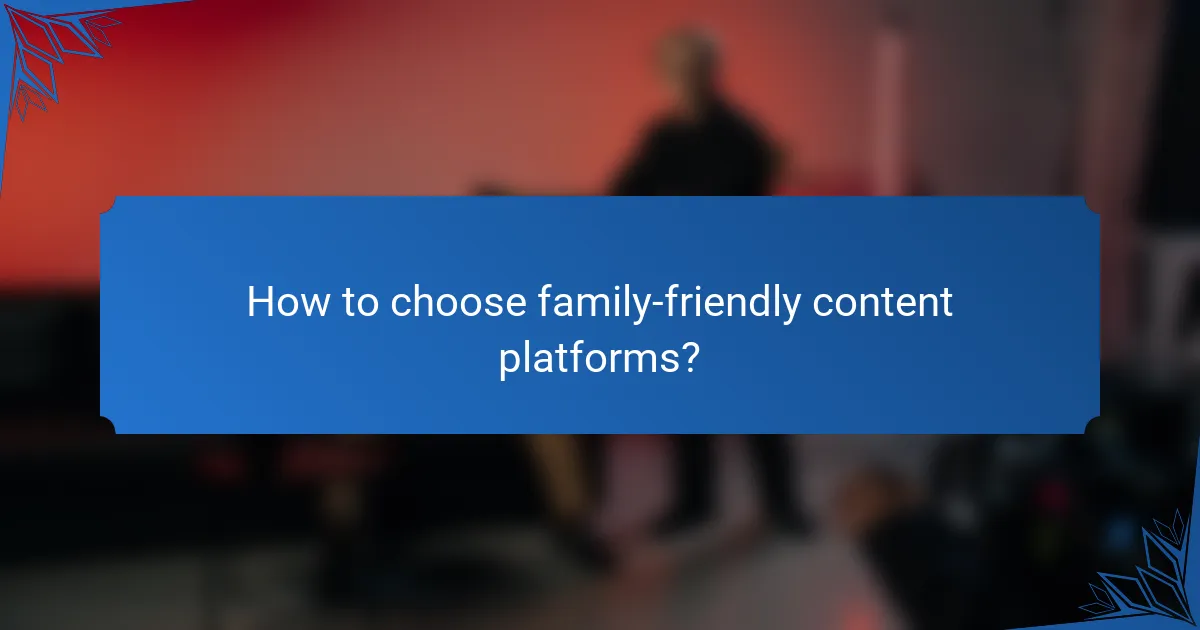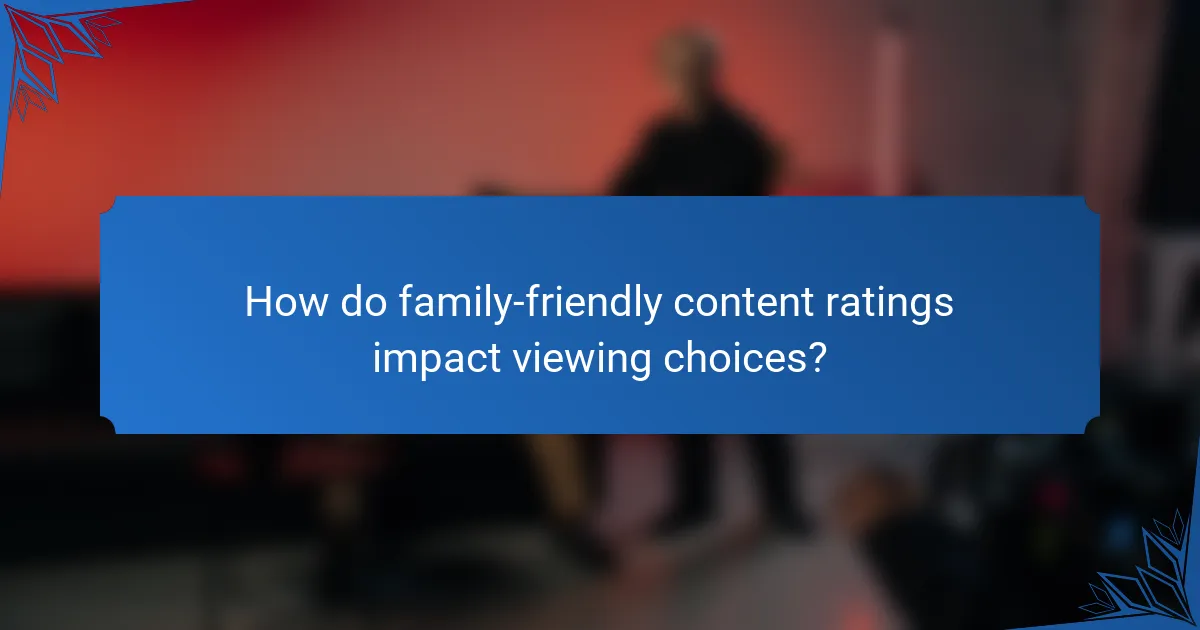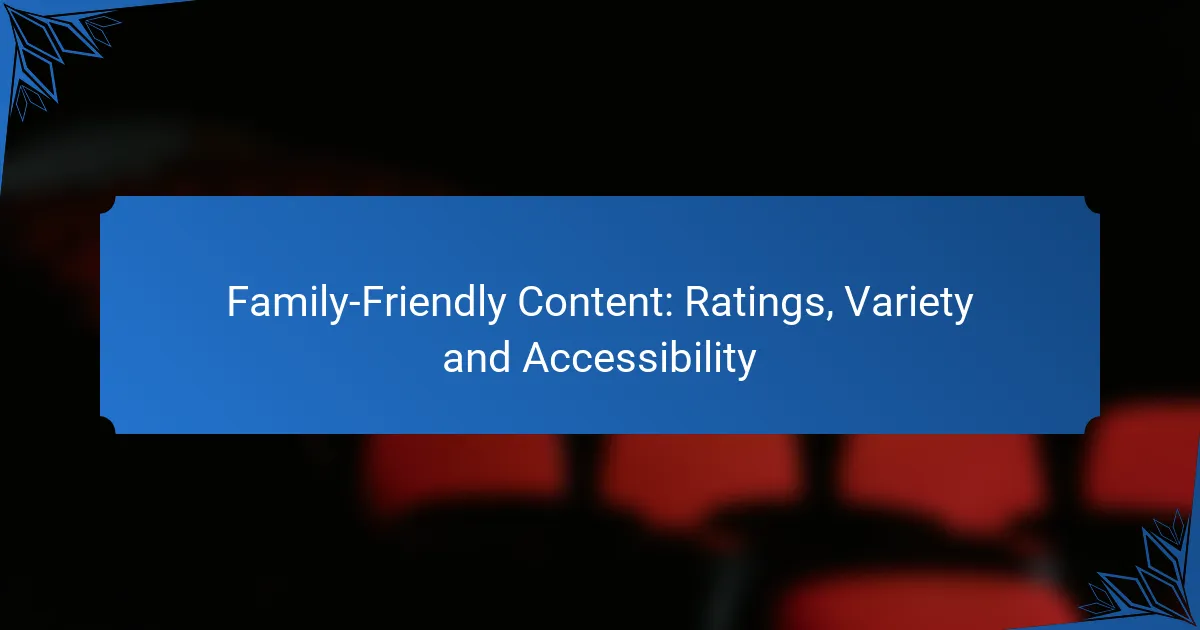When selecting family-friendly content platforms, it’s essential to consider their variety, age-appropriateness, and accessibility features. Look for options that provide a diverse range of genres, include parental controls, and offer educational value to create a safe and enriching viewing experience for children. Additionally, content ratings can guide parents in making informed decisions about what is suitable for their kids, while accessibility ensures that families can easily enjoy content across multiple devices and formats.

How to choose family-friendly content platforms?
Choosing family-friendly content platforms involves evaluating their content variety, age-appropriateness, and accessibility features. Look for platforms that offer a wide range of genres, have parental controls, and provide educational value to ensure a safe viewing experience for children.
Streaming services like Netflix
Streaming services like Netflix provide a vast library of family-friendly movies and shows, often categorized by age ratings. When selecting content, utilize the parental controls to restrict access to certain genres or ratings, ensuring that children only view suitable material.
Consider the availability of kid-specific profiles, which can help filter content based on age. Netflix, for example, offers a dedicated kids section featuring animated series and family films that are generally well-received by younger audiences.
Educational platforms like PBS Kids
Educational platforms like PBS Kids focus on providing content that is both entertaining and informative for children. These platforms often feature interactive games and videos that teach various subjects, from math to science, in a fun way.
When choosing an educational platform, look for features such as progress tracking and age-appropriate content. PBS Kids, for instance, aligns its programming with educational standards, making it a reliable choice for parents seeking quality educational resources.
Gaming platforms like Roblox
Gaming platforms like Roblox offer a unique blend of entertainment and creativity, allowing children to play games created by other users. While it encourages creativity, it’s essential to monitor gameplay to ensure a safe environment.
Utilize the platform’s privacy settings and parental controls to limit interactions with strangers and restrict certain game types. Roblox also provides educational opportunities through coding and game design, making it a versatile choice for family-friendly gaming.
Social media channels with parental controls
Social media channels with parental controls can provide a space for children to connect and share content safely. Platforms like YouTube Kids offer curated content designed for younger audiences, with features that allow parents to manage what their children can access.
When using social media, set up profiles with appropriate privacy settings and regularly review the content your children engage with. Encourage open discussions about online safety and the importance of reporting inappropriate content to foster a secure online experience.

What are the ratings for family-friendly content?
Family-friendly content is typically rated to help parents and guardians make informed decisions about what is appropriate for children. These ratings provide guidance on the suitability of movies, television shows, and video games based on their content.
MPAA ratings for movies
The Motion Picture Association of America (MPAA) assigns ratings to films based on their content, helping viewers determine suitability for children. The main ratings include G (General Audience), PG (Parental Guidance), PG-13 (Parents Strongly Cautioned), R (Restricted), and NC-17 (No One 17 and Under Admitted).
For family-friendly viewing, G and PG ratings are ideal, as they indicate minimal or no objectionable content. PG-13 may be suitable for older children, but parents should review specific themes and scenes before deciding.
TV Parental Guidelines ratings
The TV Parental Guidelines provide ratings for television programs, helping parents navigate content suitability. The ratings include TV-Y (All Children), TV-Y7 (Directed to Older Children), TV-G (General Audience), TV-PG (Parental Guidance), TV-14 (Parents Strongly Cautioned), and TV-MA (Mature Audiences).
For family viewing, TV-Y, TV-Y7, and TV-G are recommended. TV-PG can be appropriate for older kids, but parents should check for specific content warnings that may affect their decision.
ESRB ratings for video games
The Entertainment Software Rating Board (ESRB) assigns ratings to video games, indicating their appropriateness for different age groups. The ratings include EC (Early Childhood), E (Everyone), E10+ (Everyone 10 and older), T (Teen), M (Mature), and AO (Adults Only).
For family-friendly gaming, look for EC, E, or E10+ ratings. T-rated games may be suitable for teens, but it’s wise to review the content descriptors for any potentially objectionable material.

How accessible is family-friendly content?
Family-friendly content is generally designed to be widely accessible, ensuring that children and families can easily find and enjoy it across various platforms. Accessibility includes availability on multiple devices, language options, and provisions for children with disabilities.
Availability on multiple devices
Family-friendly content is typically available on a range of devices, including smartphones, tablets, smart TVs, and computers. This multi-device availability allows families to watch their favorite shows or movies at home or on the go.
Streaming services like Netflix, Disney+, and Amazon Prime Video often offer apps for various platforms, ensuring that users can access content seamlessly. It’s important to check device compatibility before subscribing to a service.
Language options and subtitles
Many family-friendly platforms provide multiple language options and subtitles to cater to diverse audiences. This feature is particularly beneficial for multilingual families or those learning a new language.
For example, popular streaming services frequently offer audio tracks in several languages and subtitles in various formats, including closed captions. Users should explore the settings menu to customize their viewing experience according to their language preferences.
Content for children with disabilities
Accessibility for children with disabilities is increasingly prioritized in family-friendly content. Many platforms now include features like audio descriptions, sign language interpretation, and enhanced visual elements to support diverse needs.
When selecting content, look for services that comply with accessibility standards, such as the Web Content Accessibility Guidelines (WCAG). This ensures that children with disabilities can enjoy the same entertainment options as their peers.

What variety of family-friendly content is available?
Family-friendly content encompasses a wide range of genres, formats, and interactive experiences designed to entertain and educate audiences of all ages. This variety ensures that families can find suitable options for different preferences and occasions.
Genres like animation and adventure
Animation and adventure are two of the most popular genres in family-friendly content. Animated films and shows often appeal to younger audiences with colorful visuals and engaging characters, while adventure stories capture the excitement of exploration and discovery.
Examples include animated classics like “Toy Story” and adventure series such as “The Magic School Bus.” These genres often convey important life lessons, making them both entertaining and educational for children.
Formats including movies and series
Family-friendly content is available in various formats, primarily movies and series. Movies typically provide a complete story in a shorter time frame, usually ranging from 60 to 120 minutes, making them ideal for family movie nights.
On the other hand, series offer episodic content that can be enjoyed over time, with episodes lasting anywhere from 20 to 30 minutes. Popular family series like “Bluey” or “The Simpsons” allow for ongoing engagement and character development.
Interactive content like quizzes and games
Interactive content, such as quizzes and games, enhances the family-friendly experience by encouraging participation and learning. Many educational websites and apps offer quizzes that test knowledge on various subjects, making learning fun.
Games, whether digital or board-based, can promote teamwork and critical thinking. Options like “Minecraft” or family trivia games are great for fostering collaboration and friendly competition among family members.

What criteria should parents consider for content selection?
Parents should consider age appropriateness, educational value, and content diversity when selecting family-friendly content. These criteria help ensure that the material is suitable, enriching, and representative of various perspectives.
Age appropriateness
Age appropriateness is crucial for ensuring that content aligns with a child’s developmental stage. Parents should check ratings and guidelines provided by organizations like the MPAA or TV Parental Guidelines, which categorize content based on age suitability.
For example, content rated for young children typically avoids complex themes and intense situations, while material for older kids may introduce more nuanced topics. Always consider the maturity level of your child when selecting content.
Educational value
Educational value refers to how well content promotes learning and critical thinking. Parents should look for programs that encourage curiosity, creativity, and problem-solving skills, as these attributes are essential for a child’s development.
Content that incorporates interactive elements or real-life applications can enhance educational benefits. For instance, shows that teach math through storytelling or science through experiments can be particularly effective.
Content diversity and representation
Diversity and representation in content help children understand and appreciate different cultures, backgrounds, and perspectives. Parents should seek out materials that feature characters from various ethnicities, genders, and abilities.
Engaging with diverse content can foster empathy and inclusivity in children. Look for shows and books that highlight stories from underrepresented groups, ensuring a more comprehensive worldview for your child.

How do family-friendly content ratings impact viewing choices?
Family-friendly content ratings significantly influence viewing choices by providing guidance on the appropriateness of films and shows for children. These ratings help parents make informed decisions about what their children can watch, ensuring that content aligns with their values and the maturity levels of their kids.
Influence on parental decisions
Parental decisions are often shaped by content ratings, which categorize media based on age suitability and thematic elements. For instance, ratings like G (General Audience) or PG (Parental Guidance) signal that content is appropriate for younger viewers, while PG-13 and R ratings indicate potential concerns for children. Parents typically rely on these ratings to filter out unsuitable material.
Many parents use ratings as a first line of defense when selecting movies or shows. They may choose to preview content or read reviews to better understand the themes and messages presented. This proactive approach helps ensure that children are exposed to age-appropriate content that aligns with family values.
Additionally, parents often discuss ratings with their children to foster understanding about why certain content is deemed inappropriate. This dialogue can help children develop critical thinking skills regarding media consumption and make better choices as they grow older.



